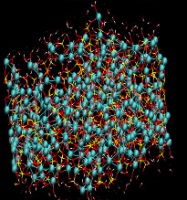ACADEMIA
CESGA supercomputer solves the 'Osteoporosis' of cements
Calculations performed by the CSIC and Tecnalia using the ability of the Supercomputing Center of Galicia (CESGA) may help in future to achieve more durable cements, more resistant to loss of calcium, reminiscent of human osteoporosis, and better able to withstand the passage of and therefore to make more secure the buildings used.
Although the material is used in the building, just behind the water, and that is present in most items of construction-houses, bridges, dams, etc-, the materials cementicios studied mainly from the standpoint of engineering, being a very recent approach from the materials science that investigates the relationship between their composition and behavior. Something that is changing thanks to the work as it develops the Unit Materials Nanoestructurales Ecoeficientes and the Higher Council for Scientific Research (CSIC) in collaboration with the research center Tecnalia.
The researcher Jorge Sanchez buffed, the Tecnalia, explains that in recent years "began to perform, especially in America, a more scientific approach in research of materials cementicios conxugaba that the use of sophisticated techniques such as characterization nanoindentación with modern techniques computer simulation and allow you to decipher the turns of nanostructures cementicia ".
This new approach is what we are following researchers from the CSIC and Tecnalia: investigators linked this unit recently participated in European projects (COmputationally-Driven design of Innovative Materials CEmentitious, Codex, www.codice-project.eu ), led by Jorge Sanchez self buffed, and whose ultimate goal was precisely the computational design of new materials cementicios.
Using the capabilities of the Supercomputing Center of Galicia (CESGA) "perform simulations of different materials and are assembled as we study, say the study 'bricks' fundamental of these materials, or by making a comparison, its DNA," indicated Sanchez buffed.
The use of supercomputers allows simulating the behavior of materials at atomic level, identifying the key components of the cements, which are "balls of five nanometers"-a nanometer is a unit of length equivalent to one billionth of a meter-. It is thus possible, using suitable software, play "as are assembled with each other and how the properties change," said the researcher, who notes that there are parallels with the behavior of polymers, macromolecules of organic origin-such as the cellulose or the or synthetic silk-like-the-Nylon.
Studying how these beads are assembled or 'bricks' fundamental cements makes it possible to know better the processes of degradation and suffering durability. Currently it is already known that, as in cholesterol, there are cements good and bad: the good ones are those where the components are "too packed" and better resist "attacks of degradation."
The research will directed, first, to get the good components are those that prevail in the composition of the material cementante, and the other to achieve greater resistance to a phenomenon similar to that osteoporosis affects the bones of people: the loss of calcium . The penetration of moisture through the pores of the structures cementicias causes the progressive disappearance of calcium from the skeleton and cementicio "that it becomes more brittle and eventually break," said Sanchez buffed, a phenomenon for which you seek solutions through research.
